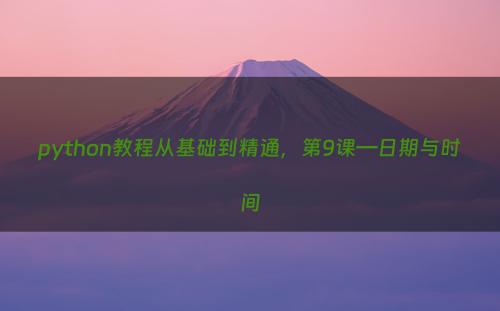网站首页 > 基础教程 正文
Hello,小伙伴们,祝大家五.一玩得快乐!
刚学习完了七大数据类型,今天咱们来学习日期与时间的表示方法。

Python标准库中提供了时间和日期的支持:
calendar:日历相关;
time、datetime:时间相关;
格式化当前时间:
time模块:time.strftime('%Y-%m-%d', time.localtime(time.time()))
datetime模块:datetime.datetime.now().strftime('%Y-%m-%d')
1、time模块
时间的主要三种表示方式:
1)时间戳:1970-1-1至今的秒数(float),time.time();
2)格式化时间字符串:如'2018-11- 07 20:23',time.strftime('%Y-%m-%d', struct_time);
3)结构化时间time.struct_time:包含年月日等的元组,time.localtime(tm);
1.1、时间格式化
其中,struct_time是一个9元组:
格式化输出见下表:
1.2、time模块的应用
可以获取当前时间的年月日时分秒,可以延时或计时,输出精确到毫秒(%f为微秒,去掉后三位则近似毫秒)。
光看函数很晦涩,所以咱们还是先来看一下这些函数的应用吧:
import time
#time,从 1970 年 1 月 1 日 00:00:00 到当前时间的秒数
a=time.time()
print(a)
#ctime,显示现在时间, Fri Apr 28 22:56:29 2023
print(time.ctime())
#sleep
# Start : Fri Apr 28 23:10:53 2023
# End : Fri Apr 28 23:10:53 2023
print("Start : %s" % time.ctime(a))
time.sleep(5) #浅睡眠5秒钟
print("End : %s" % time.ctime(a))
#localtime,以年月日的形式显示现在时间
#time.struct_time(tm_year=2023, tm_mon=4, tm_mday=28,
#tm_hour=23, tm_min=10, tm_sec=53, tm_wday=4, tm_yday=118, tm_isdst=0)
b=time.localtime(a)
print(b)
print(time.strftime('%Y-%m-%d %H:%M:%S',b)) # 显示年-月-日-时-分-秒
print(time.strftime('%Y-%m-%d %H:%M',b)) # 显示年-月-日-时-分
print(time.strftime('%Y-%m-%d',b)) # 2023-04-28
#gmtime
#time.struct_time(tm_year=2023, tm_mon=4, tm_mday=28, tm_hour=15,
#tm_min=10, tm_sec=53, tm_wday=4, tm_yday=118, tm_isdst=0)
print("Local time in UTC format :",time.gmtime(a))
#mktime
b=(2019,8,6,10,40,34,1,218,0)
print("Current Time in seconds :",time.mktime(b))
#asctime,Tue Aug 6 10:40:34 2019
print("Current Time in local format :",time.asctime(b))
#strftime
c = time.localtime() # get struct_time
d = time.strftime("%m/%d/%Y, %H:%M:%S", c)
print("String representing date and time:",d) #04/28/2023, 23:10:58
#strptime
e = "06 AUGUST, 2019"
f = time.strptime(e, "%d %B, %Y")
print(f)
#time.struct_time(tm_year=2019, tm_mon=8, tm_mday=6, tm_hour=0,
#tm_min=0, tm_sec=0, tm_wday=1, tm_yday=218, tm_isdst=-1)
1.3、time模块中主要函数
1.4、休眠及运行时间
2、datetime模块
datetime模块定义了下面这几个类:
2.1、date类
date类定义了一些常用的类方法与类属性:
示例代码:
from datetime import date
import time
print('最大日期:', date.max) #最大日期: 9999-12-31
print('最小日期:', date.min) #最小日期: 0001-01-01
print('最小日期单位:', date.resolution) #最小日期单位: 1 day, 0:00:00
print('今天日期:', date.today()) #今天日期: 2023-04-29
print('根据时间戮,返回一个date对象:', date.fromtimestamp(time.time()))
#根据时间戮,返回一个date对象: 2023-04-29
2.2、date提供的实例方法和属性
还可以作日期的加减,示例代码:
from datetime import datetime, date, timedelta
today = date.today()
print(today) #2023-04-29
print(today.year) #2023
print(today.month) #4
print(today.replace(year=2017)) #2017-04-29,今年换成2017
print(today.weekday()) #5,星期五
print(today.isoweekday()) #6,从周天开始算起第几天
print(today.isocalendar()) #datetime.IsoCalendarDate(year=2023, week=17, weekday=6)
print(today.isoformat()) # 2023-04-29,返回格式如’YYYY-MM-DD’的字符串
print(today.strftime('%Y-%m-%d')) # 2023-04-29,按"年-月-日"格式输出日期
print(today.toordinal()) # 738639,格里历的今天
import datetime
day1 = datetime.date(2020,9,1)
day2 = datetime.date(2021,9,1)
day3 = day1 + timedelta(6)
day4 = day2 - timedelta(6)
print(day2 - day1) #365 days, 0:00:00
print(day2 > day1) #True
print(day3) #2021-09-07
print(day4) #2021-08-26
2.3、time类
time类的构造函数如下:(其中参数tzinfo,它表示时区信息。)
class datetime.time(hour[, minute[, second[, microsecond[, tzinfo]]]])
time类定义的类属性:
time类提供的实例方法和属性:
像date一样,也可以对两个time对象进行比较,或者相减返回一个时间间隔对象。这里就不提供例子了。
2.4、datetime类
datetime是date与time的结合体,包括date与time的所有信息。它的构造函数如下:datetime.datetime(year, month, day[, hour[, minute[, second[, microsecond[, tzinfo]]]]]),各参数的含义与date、time的构造函数中的一样,要注意参数值的范围。
datetime类定义的类属性与方法:
示例代码:
from datetime import datetime
import time
print('最大日期:', datetime.max)
print('最小日期:', datetime.min)
print('最小日期单位:', datetime.resolution)
print('today():', datetime.today())
print('now():', datetime.now())
print('utc样式的时间:', datetime.utcnow())
print('将本地时间作为输入:', datetime.fromtimestamp(time.time()))
print('将UTC时间作为输入:', datetime.utcfromtimestamp(time.time()))
date_str = "2022-01-01 12:00:00"
date_obj = datetime.strptime(date_str, '%Y-%m-%d %H:%M:%S') #成了日期变量
print(date_obj) #2022-01-01 12:00:00
输出结果
像date一样,也有同样的方法和属性,也可以对两个datetime对象进行比较,或者相减返回一个时间间隔对象,或者日期时间加上一个间隔返回一个新的日期时间对象。
2.5、timedelta类、tzinfo类
(1)timedelta类
通过timedelta函数返回一个timedelta对象,也就是一个表示时间间隔的对象。函数参数情况如下所示:
class datetime.timedelta([days[, seconds[, microseconds[, milliseconds[, minutes[, hours[, weeks]]]]]]])
其没有必填参数,简单控制的话第一个整数就是多少天的间隔的意思:
datetime.timedelta(10)
两个时间间隔对象可以彼此之间相加或相减,返回的仍是一个时间间隔对象。而更方便的是一个datetime对象如果减去一个时间间隔对象,那么返回的对应减去之后的datetime对象,然后两个datetime对象如果相减返回的是一个时间间隔对象。这很是方便。
(2)tzinfo类
tzinfo是一个抽象类,不能被直接实例化。需要派生子类,提供相应的标准方法。datetime模块并不提供tzinfo的任何子类。最简单的方式是使用pytz模块。
3、Calendar模块
此模块的函数都是日历相关的,星期一是默认的每周第一天,星期天是默认的最后一天。更改设置需调用calendar.setfirstweekday()函数。
示例代码如下 :
import calendar
c0 = calendar.firstweekday() # 输出:0
calendar.setfirstweekday(1) # 设置周一为1
c1 = calendar.firstweekday() # 输出:1
print(calendar.isleap(2022)) # False
print(calendar.leapdays(2000,2022)) # 6
print(calendar.month(2022, 9, w=2, l=1)) #后面两项可省
# September 2022
# Tu We Th Fr Sa Su Mo
# 1 2 3 4 5
# 6 7 8 9 10 11 12
# 13 14 15 16 17 18 19
# 20 21 22 23 24 25 26
# 27 28 29 30
print(calendar.monthcalendar(2022,9))
# [[0, 0, 1, 2, 3, 4, 5], [6, 7, 8, 9, 10, 11, 12], [13, 14, 15, 16, 17, 18, 19],
# [20, 21, 22, 23, 24, 25, 26], [27, 28, 29, 30, 0, 0, 0]]
print(calendar.monthrange(2022, 9)) # (3, 30)
print(calendar._monthlen(2022, 9)) # 30
print(calendar.weekday(2022,9,30)) # 4
print(calendar._prevmonth(2022, 1)) # (2021, 12)
print(calendar._prevmonth(2022, 4)) # (2022, 3)
print(calendar._nextmonth(2022, 12)) # (2023, 1)
print(calendar._nextmonth(2022, 9)) # (2022, 10)
愉快学习的时光总是过得很快,一不小心又到结尾啦。
先来给自己一个奖励,双手举起,yeah!
有什么问题可以关注我/私信我/加好友,让我们一起成长吧。
猜你喜欢
- 2025-01-05 一文搞懂python日期时间处理-datetime模块
- 2025-01-05 如何实现Python+selenium在指定时间自动运行程序
- 2025-01-05 Python模块datetime、calendar、logging、argparse、re用法
- 2025-01-05 Python常见模块机os、sys、pickle、json、time用法
- 2025-01-05 Python版的迷你程序——年月日时分秒
- 2025-01-05 用于清理数据的 5 个简单有效 Python 脚本
- 2025-01-05 学姐教你:用Python设计生日提醒小助手,永远不会忘记重要日子啦
- 2025-01-05 ABB机器人与Python通讯
- 2025-01-05 python内置模块datetime.date类详细介绍
- 2025-01-05 python 基础(四)
- 01-07Python从入门到放弃-详解列表、元组和字典
- 01-07python 中字典如何进行复制
- 01-07python入门023:字典嵌套
- 01-07掌握Python字典的12个例子
- 01-07使用Python 获取多级字典(Json)格式所有Key、Value
- 01-07简单学Python——字典的操作1(增加、更改和删除字典元素)
- 01-07Python之容器拾遗:Python就是包裹在一堆语法糖中的字典
- 01-07深入了解python字典的有序特性
- 最近发表
- 标签列表
-
- gitpush (61)
- pythonif (68)
- location.href (57)
- tail-f (57)
- pythonifelse (59)
- deletesql (62)
- c++模板 (62)
- css3动画 (57)
- c#event (59)
- linuxgzip (68)
- 字符串连接 (73)
- nginx配置文件详解 (61)
- html标签 (69)
- c++初始化列表 (64)
- exec命令 (59)
- canvasfilltext (58)
- mysqlinnodbmyisam区别 (63)
- arraylistadd (66)
- node教程 (59)
- console.table (62)
- c++time_t (58)
- phpcookie (58)
- mysqldatesub函数 (63)
- window10java环境变量设置 (66)
- c++虚函数和纯虚函数的区别 (66)
